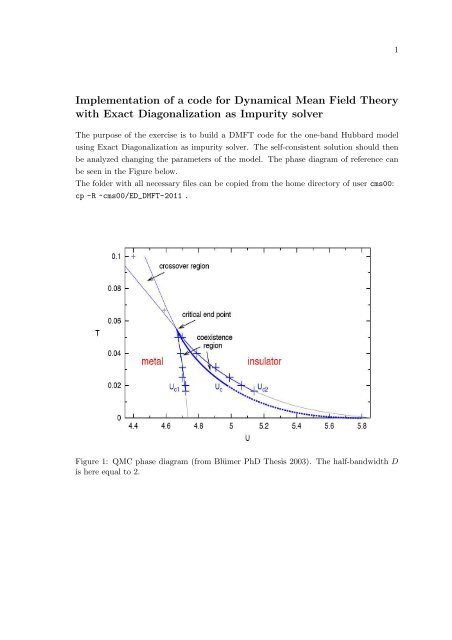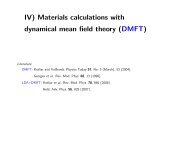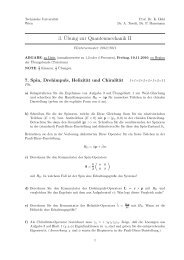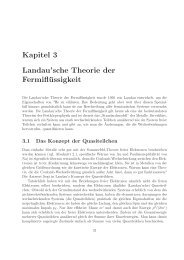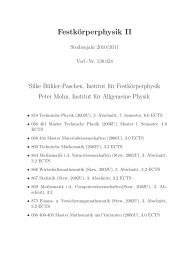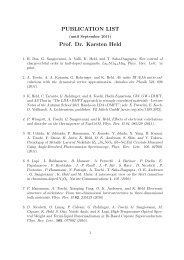Implementation of a code for Dynamical Mean Field Theory with ...
Implementation of a code for Dynamical Mean Field Theory with ...
Implementation of a code for Dynamical Mean Field Theory with ...
Create successful ePaper yourself
Turn your PDF publications into a flip-book with our unique Google optimized e-Paper software.
1<strong>Implementation</strong> <strong>of</strong> a <strong>code</strong> <strong>for</strong> <strong>Dynamical</strong> <strong>Mean</strong> <strong>Field</strong> <strong>Theory</strong><strong>with</strong> Exact Diagonalization as Impurity solverThe purpose <strong>of</strong> the exercise is to build a DMFT <strong>code</strong> <strong>for</strong> the one-band Hubbard modelusing Exact Diagonalization as impurity solver. The self-consistent solution should thenbe analyzed changing the parameters <strong>of</strong> the model. The phase diagram <strong>of</strong> reference canbe seen in the Figure below.The folder <strong>with</strong> all necessary files can be copied from the home directory <strong>of</strong> user cms00:cp -R ~cms00/ED_DMFT-2011 .Figure 1: QMC phase diagram (from Blümer PhD Thesis 2003). The half-bandwidth Dis here equal to 2.
2mini How-To1. The loop begins <strong>with</strong> file lisadiag.andpar containing, exactly as we did in Exercise2, the starting Anderson parameters (use just a, possibly educated, guess).2. As in Exercise 2, lisadiag.dat and lisadiag.input contain the other necessaryparameters.3. To get the impurity Green’s function on the Matsubara frequencies (iω n = iπT(2n+1)) at each iteration, the Anderson Impurity Model (AIM) <strong>code</strong> we worked <strong>with</strong>during Exercise 2 can be used. It is also possible to use the version <strong>of</strong> lisadiag.fprovided here. The only thing to change is the definition <strong>of</strong> the frequencies: Nowthe Green’s function on the Matsubara axis is needed, instead <strong>of</strong> on real frequenciesas it was <strong>for</strong> Exercise 2. Either all or positive frequencies only, can be used. Thetwo places where this has to be done are marked by “?? Matsubara ??”.4. the solution <strong>of</strong> the AIM yields lisadiag.green containing G(iω n ).5. the DMFT self-consistency condition <strong>for</strong> the Bethe lattice case readsG 0 (iω n ) −1 = iω n + µ − D24 G(iω n)where D is the half-bandwidth. This equation can there<strong>for</strong>e be used to get the “new”G 0 (iω n ).IMPORTANT: This has to be written on the file G0w.dat, which is needed by theprogramfit.f. The <strong>for</strong>mat <strong>of</strong> such file is described below, as well as programfit.f.Additionally, to avoid possible oscillations between different solution during theDMFT loop, it would be desirable to mix the “new” G 0 (iω n ) - be<strong>for</strong>e writing itto the file G0w.dat - <strong>with</strong>, e.g., the non-interacting Green’s function <strong>of</strong> the AIM,namelyG And0 (iω n ) −1 = iω n + µ − ∑ kV 2kiω n − ǫ kAlternatively, the G 0 (iω n ) <strong>of</strong> the previous step can be used <strong>for</strong> the mixing.6. From the “new” G 0 (iω n ), the “new” Anderson parameters can be obtained througha fitting procedure. This can be done using the small program fit.f provided here.Program fit.f can be compiled in the following way:g<strong>for</strong>tran -fbounds-check -O fit.f -o FIT.x
3It looks into lisadiag.dat to initialize several arrays. Recompiling is necessaryevery time Ns and/or Iwmax are changed in file lisadiag.dat. The <strong>code</strong> alsoreads the Anderson parameters from lisadiag.andpar and the chemical potentialfrom lisadiag.input. These three files are expected to have the same <strong>for</strong>mat asthose used during Exercise 2 <strong>for</strong> the AIM <strong>code</strong>.7. As we already said, fit.f needs file G0w.dat to read G 0 (iω n ) from. This file has tocontain Iwmax (defined in lisadiag.dat) lines and three columns: The (real part<strong>of</strong> the) Matsubara frequency in the first column, and the real and imaginary part <strong>of</strong>G 0 (iω n ) in the second and third columns.8. The output <strong>of</strong>fit.f is a new set <strong>of</strong> Anderson parameters, contained in filenew.andpar.The <strong>for</strong>mat is the same as lisadiag.andpar, so simply copying new.andpar intolisadiag.andpar will be enough to start over <strong>with</strong> a new iteration.9. To check whether self-consistence has been reached, the AIM Green’s function G(iω n )can be plotted as a function <strong>of</strong> the iterations. When the changes in both the real andthe imaginary parts <strong>of</strong> G(iω n ) between to consecutive iterations are negligible, a selfconsistentsolution has been reached. A saturation in the values <strong>of</strong> the Andersonparameters as a function <strong>of</strong> the iteration also indicates that self-consistency hasbeen reached. More quantitative estimates <strong>of</strong> the convergece parameter would giveunambiguous results, but are not really needed in this context.Typically, <strong>of</strong> the order <strong>of</strong> 10-20 iterations are enough to converge, unless too fewAnderson parameters are used or unless there is a phase transition or a critical pointclose by. In those cases more iterations are needed, and the intial guess <strong>for</strong> theAnderson parameters becomes important.10. A consideration about the values <strong>of</strong> the Anderson parameters: These are determinedby a multi-dimensional fit <strong>of</strong> G 0 (iω n ) <strong>with</strong> the functional <strong>for</strong>m G0 And (iω n ) −1 =iω n + µ − ∑ Vk2k iω n−ǫ k. This has no unique solution and since many regions <strong>of</strong> theparameter space can have shallow minima, tiny differences coming from roundingerrors can give different results <strong>for</strong> the final set <strong>of</strong> the Anderson parameters. Thismakes comparisons between different implentations <strong>of</strong> the self-consistency loop abit complicated. However, the values <strong>of</strong> the Anderson parameters have no physicalmeaning individually. Physical quantities like, e.g. the Green’s function, will dependmuch less on these small differences.


